
Olearia axillaris, commonly known as coastal daisy-bush, coast daisy-bush or coastal daisybush is a species of flowering plant in the family Asteraceae and is endemic to coastal areas of Australia. It is an erect, bushy shrub with densely cottony-hairy branchlets, aromatic, linear to narrowly elliptic or narrowly lance-shaped to egg-shaped leaves with the narrower end towards the base and small white and yellow, daisy-like inflorescences.

Pomaderris aspera, commonly known as hazel pomaderris, is a species of flowering plant in the family Rhamnaceae and is endemic to south-eastern Australia. It is a shrub or small tree with elliptic to lance-shaped or egg-shaped leaves and greenish-yellow flowers.

Pomaderris intermedia, commonly known as lemon dogwood, is a species of flowering plant in the family Rhamnaceae and is endemic to south-eastern Australia. It is a shrub with hairy stems, elliptic to egg-shaped leaves, and clusters of yellow flowers.

Persoonia trinervis is a species of flowering plant in the family Proteaceae and is endemic to the south-west of Western Australia. It is an erect, sometimes spreading shrub with densely hairy young branchlets, spatula-shaped or lance-shaped leaves with the narrower end towards the base, and densely hairy yellow flowers.

Conospermum hookeri, commonly known as Tasmanian smokebush, is a species of flowering plant in the family Proteaceae and is endemic to Tasmania. It is a shrub with many branches, spatula-shaped or linear leaves, panicles of spikes of white, tube-shaped flowers and reddish brown nuts covered with silky fawn-coloured hairs.
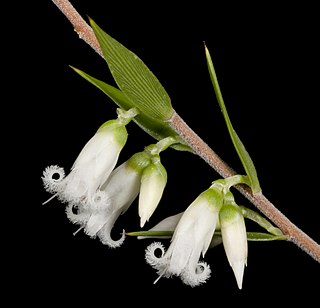
Styphelia conostephioides is a flowering plant in the family Ericaceae and is endemic to the south-west of Western Australia. It is an erect, straggling shrub with lance-shaped leaves with a sharp point on the tip, and white flowers arranged in pairs in leaf axils.

Pultenaea capitellata, commonly known as hard-head bush-pea, is a species of flowering plant in the family Fabaceae and is endemic to south-eastern continental Australia. It is a sprawling to prostrate shrub with elliptic to broadly egg-shaped leaves, and yellow to orange flowers with a red to purple keel.

Pultenaea echinula, commonly known as curved bush-pea, is a species of flowering plant in the family Fabaceae and is endemic to a small area of New South Wales. It is an erect shrub with linear, needle-shaped, grooved leaves, and dense clusters of yellow to orange and red flowers.

Pultenaea euchila, commonly known as orange pultenaea, is a species of flowering plant in the family Fabaceae and is endemic to eastern Australia. It is an erect shrub with glabrous foliage, narrow egg-shaped leaves with the narrower end towards the base, and orange-coloured flowers arranged singly or in small groups near the ends of branchlets.
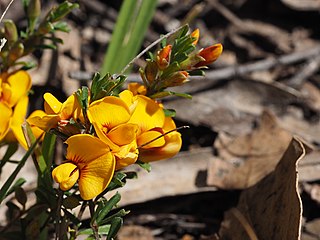
Pultenaea microphylla is a species of flowering plant in the family Fabaceae and is endemic to eastern Australia. It is an erect to prostrate shrub with narrow egg-shaped leaves with the narrower end towards the base, and clusters of up to ten yellow to red flowers with reddish markings.

Pomaderris ligustrina, commonly known as privet pomaderris, is a species of flowering plant in the family Rhamnaceae and is endemic to south-eastern continental Australia. It is a shrub with hairy stems, lance-shaped to narrowly elliptic leaves, and loose clusters of cream-coloured or yellow flowers.

Sprengelia monticola, commonly known as rock sprengelia, is a species of flowering plant of the family Ericaceae, and is endemic to the Blue Mountains in eastern New South Wales. It is an open or low-lying shrub with egg-shaped to lance-shaped leaves, and white flowers arranged singly in leaf axils.
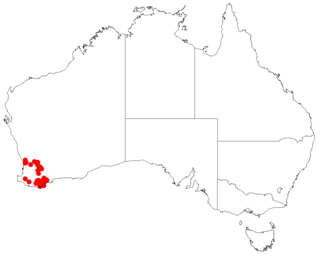
Styphelia cymbiformis is a flowering plant in the family Ericaceae and is endemic to the south-west of Western Australia. It is a bushy or wiry shrub that typically grows to a height of 30–50 cm (12–20 in) and has more or less glabrous branches. Its leaves are erect, linear to lance-shaped and sharply-pointed, mostly 2–4 mm (0.079–0.157 in) long. The flowers are arranged in short spikes, sometimes of only two or three flowers, with lance-shaped, leaf-like bracts, and bracteoles half as long as the sepals at the base of the spikes. The sepals are 2.5–3.0 mm (0.098–0.118 in) long and the petals slightly longer than the sepals, the lobes shorter than the petal tube.

Leucopogon melaleucoides is a species of flowering plant in the heath family Ericaceae and is endemic to eastern Australia. It is an erect, densely branched shrub with lance-shaped or egg-shaped leaves, and white, tube-shaped flowers arranged in spikes in upper leaf axils.

Leucopogon pimeleoides is a species of flowering plant in the heath family Ericaceae and is endemic to eastern Australia. It is a shrub with narrowly egg-shaped leaves and spikes of white, bearded flowers.

Styphelia angustifolia is a species of flowering plant in the heath family Ericaceae and is endemic to eastern New South Wales. It is an erect shrub with lance-shaped to narrowly egg-shaped leaves and pale green, pendent flowers in summer.
Brachyloma baxteri is a species of flowering plant in the family Ericaceae and is endemic to the south-west of Western Australia. It is an erect or diffuse shrub with linear leaves and red, tube-shaped flowers.
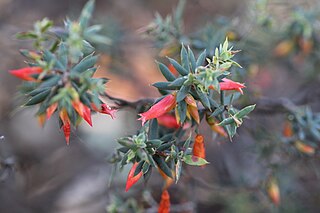
Styphelia epacridis is a flowering plant in the family Ericaceae and is endemic to the south-west of Western Australia. It is a straggling shrub with lance-shaped or linear leaves with a sharp point on the tip, and red, tube-shaped flowers arranged singly in leaf axils.
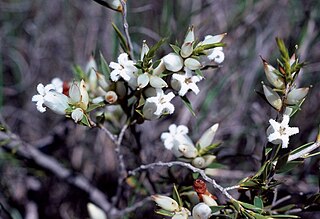
Styphelia xerophylla is a species of flowering plant in the heath family Ericaceae and is endemic to the south-west of Western Australia. It is an erect, compact shrub with egg-shaped to narrowly egg-shaped leaves and white, tube-shaped flowers with hairy lobes.

Acrotriche affinis, commonly known as ridged ground-berry or prickly honeypots, is a species of flowering plant in the family Ericaceae, and is endemic to south-eastern, continental Australia. It is an erect shrub with many branches, lance-shaped leaves, and spikes of tube-shaped, greenish flowers, and white, spherical drupes.




















